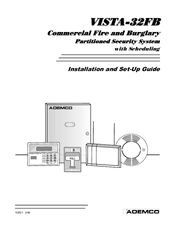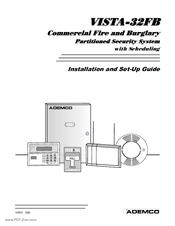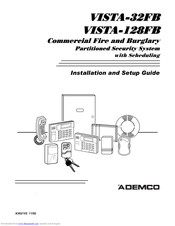Ademco VISTA-32FB Manuals
Manuals and User Guides for Ademco VISTA-32FB. We have 7 Ademco VISTA-32FB manuals available for free PDF download: Installation And Setup Manual, Installation And Setup User's Manual, User Manual, Quick Start Manual, Programming Manual
ADEMCO VISTA-32FB Installation And Setup Manual (216 pages)
fire and burglary partitioned security system with scheduling
Brand: ADEMCO
|
Category: Security System
|
Size: 1 MB
Table of Contents
Advertisement
ADEMCO VISTA-32FB Installation And Setup User's Manual (216 pages)
Commercial Fire and Burglary Partitioned Security System with Scheduling
Brand: ADEMCO
|
Category: Security System
|
Size: 1 MB
Table of Contents
Ademco VISTA-32FB Installation And Setup Manual (128 pages)
Commercial Fire and Burglary Partitioned Security System with Scheduling
Brand: Ademco
|
Category: Security System
|
Size: 1 MB
Table of Contents
Advertisement
Ademco VISTA-32FB User Manual (80 pages)
Commercial Burglary Alarm System
Brand: Ademco
|
Category: Security System
|
Size: 0 MB
Table of Contents
Ademco VISTA-32FB Programming Manual (56 pages)
Commercial Fire and Burglary Partitioned Security System with Scheduling
Brand: Ademco
|
Category: Security System
|
Size: 0 MB
Table of Contents
Ademco VISTA-32FB Quick Start Manual (60 pages)
Commercial fire and burglary partitioned security system with Scheduling
Brand: Ademco
|
Category: Security System
|
Size: 0 MB
Table of Contents
ADEMCO VISTA-32FB Quick Start Manual (5 pages)
Brand: ADEMCO
|
Category: Security Sensors
|
Size: 0 MB






